![]()
![]()
![]()
Use LEFT and RIGHT arrow keys to navigate between flashcards;
Use UP and DOWN arrow keys to flip the card;
H to show hint;
A reads text to speech;
103 Cards in this Set
- Front
- Back
|
Authorized actions to meet required COF:
|
1) Change runways (if applicable)
2) Use 1500’ clean-up option 3) Reduce fuel load 4) Select zero-flap (Not authorized for student approaches) 5) Select ACM-off (this should only be used for initial take off) 6) Wait for temperature to decrease |
|
|
If using the 1500’ climbout profile with 10 flaps for initial takeoff or touch and goes, ___
|
crews may raise flaps at 400’ if both engines are operating normally
|
|
|
When operating under day VMC conditions, aircrews may, with specific Sup approval, ___
|
reduce the climb gradient required by 48’/nm
|
|
|
IFR climbs require ___
VFR climbs require ___ |
200 feet/NM (3.3 % gradient)
152 feet/NM (2.5 % gradient) |
|
|
Icing may require use of engine anti-ice on the ground
If required, engine anti-ice can reduce ___ |
engine performance resulting up to 2.0 reduction in COF
|
|
|
If anti-ice is required during the climb profile, you must ___
|
use the second segment climb to determine your climbout factor that is required
The second column of the postage stamp (or climb >400 feet) |
|
|
Procedure turn (PT)
Parallel (Direct or Parallel) Should correct back to the outbound course with at least ___ intercept if on the non-maneuvering side in excess of ___. |
20°
180 KTAS |
|
|
Procedure turn (PT)
You may use normal lead points for your turns if your ___ |
heading is within 90° of the outbound track.
|
|
|
Procedure turn (PT 45/180)
AFMAN 11-217 specifies that timing on the 45° leg is ___, 1 minute for categories A and B. Timing starts upon ___. |
1+15 for categories C and higher
initiating the 45° turn |
|
|
The distance you travel outbound before starting the maneuver is ___,
however, you ___. As a technique, subtract (3 x Turn Radius) + 2 from the specified remain within distance to determine the maximum distance that the aircraft should travel outbound prior to initiating the 45° turn. |
entirely your choice
must remain within the specified distance |
|
|
Procedure turn (PT 45/180)
If the inbound procedure turn course is within ___, turn outbound toward the ___the inbound procedure turn course. |
70° of the aircraft heading
maneuvering side to parallel |
|
|
Procedure turn (PT 45/180)
If the inbound procedure turn course is not within ___, turn outbound in the shorter direction ___ |
70° of the aircraft heading
to parallel or intercept the inbound course |
|
|
Procedure turn (PT 45/180)
As a technique, you may use the ICAO 30° entry cone on each side if the Pt fix to determine if you want to fly ___ or just ___ to reverse course |
the barb
turn towards the maneuvering side |
|
|
Procedure turn (PT Teardrop)
Conveniently aligned. ___ maximum teardrop angle. If 45° was used, you might exceed protected airspace. If course guidance is available, ___. |
30°
attempt to intercept and maintain a selected teardrop course |
|
|
PT Fix altitude
Start descent: 45/180 abeam on a ___ or ___ to the outbound track Otherwise abeam the procedure turn fix heading outbound. If you cannot determine when you are abeam, start your descent after ___. |
parallel
intercept heading completing the outbound turn |
|
|
PT Altitude.
Established on ___. At that point, obstacle clearance is based on attempting to maintain the published inbound course |
the inbound segment
|
|
|
When not to fly the PT: (SNERT)
|
1. Issued an ATC clearance for a "Straight in" approach.
2. Initial approach is via a "No PT" routing. 3. Established in a published or assigned holding pattern, subsequently cleared for the approach, and the holding course and the procedure turn course are the same. 4. ATC Radar vectors the aircraft to final approach course 5. Conducting “Timed approaches” from a holding fix. |
|
|
Holding in lieu of Procedure Turn
Entry: Holding pattern rules apply. 1. Maximum teardrop is ___. 2. No correction required if on the ___. |
45°
non-holding side |
|
|
Weather Required
Do not file to a destination unless the ceiling and visibility for the |
estimated time of arrival (ETA) (plus or minus 1 hour) is at or above the appropriate PWC or suitable published minimums, whichever is greater.
|
|
|
Weather Required
EXCEPTION: If ___ are available, aircrews may file flight plans ___ when the terminal weather is forecast to be below published landing minimums.) Aircrews will compute divert fuel for the most distant alternate. |
two or more suitable alternate airfields
TO the home field |
|
|
Temporary (TEMPO) Conditions
Pilots may file to a destination whose forecast includes temporary (TEMPO) changes in |
ceiling and/or visibility that are lower than [minimums], but an alternate may be required.
|
|
|
Holding in lieu of Procedure Turn
As soon as you __ you're established in the protected airspace and may descend. If descent on the inbound segment is depicted, the maximum difference between IAF and FAF altitudes will be ___ |
pass the IAF
300 ft. |
|
|
Times when a HILO PT will not be flown (7)
|
1. Issued an ATC clearance for a "straight-in" approach.
2. Initial approach is via a "No PT" routing. 3. ATC radar vectors the aircraft to final approach course. 4. Established in the published holding pattern (in lieu of procedure turn) and the aircraft is at an altitude from which the approach can be safely executed. 5. Additional circuits of the holding pattern are neither necessary nor expected by ATC. 6. If additional circuits are required to lose excessive altitude, request them from ATC. 7. Conducting “timed approaches” from the holding fix. |
|
|
Procedural Track
If you are within ___ you are not required overfly the IAF. Use normal lead points. |
90°
|
|
|
Procedural Track
Initial descent. At the IAF descend when ___ to the procedural track course. |
abeam or past on a parallel or intercept heading
|
|
|
Procedural Track
Once a lead point is reached and a turn to the next segment is begun, ___ on the next segment and descend to the next applicable altitude. |
pilots may consider themselves established
|
|
|
Procedural Track
When an altitude restriction is depicted at a fix defined as an intersection of a radial and an arc, the restriction must be complied with ___ associated with that fix. . If the restriction is met during the lead turn, ___, and you may continue to descend to the next applicable altitude restriction. |
Procedural Track
When an altitude restriction is depicted at a fix defined as an intersection of a radial and an arc, the restriction must be complied with no later than the completion of the lead turn associated with that fix. If the restriction is met during the lead turn, consider yourself established on the next segment, and you may continue to descend to the next applicable altitude restriction. |
|
|
The T-1 A will not be flown in areas of forecast or known _____
|
severe icing or turbulence, freezing rain or drizzle.
|
|
|
Do not _____ or ____ in actual moderate icing conditions
|
Cruise or conduct multiple pattern operations
|
|
|
If required WX mins cannot be maintained during a low level ______
|
Abort the route
|
|
|
Do not exceed ______ of bank in IMC unless safety of flight dictates otherwise.
|
30 degrees
|
|
|
What is the minimum runway length for takeoff?
|
6,000 ft, CFL, or the distance required to reach reference zero, whichever is greater
|
|
|
What is the minimum runway for full stop landings?
|
6,000 ft or computed landing distance; whichever is greater
|
|
|
What is the minimum runway length for touch and go’s?
|
Must be equal or greater than applicable touch and go distance but never less than 6000 feet.
|
|
|
Can a T-1 A accept an intersection T/O?
|
Yes as long as runway remaining is at least 6,000 ft, CFL, or distance required to reach reference zero, whichever is greater.
|
|
|
Can we do touch and goes when ice or snow is on the runway?
|
No
|
|
|
What factor should be considered when determining minimum usable runway for TOLD problems?
|
The minimum runway usable is computed between arresting cables located on or above the runway surface.
|
|
|
What type of full stop landing is prohibited?
|
No flap
|
|
|
Do not practice single engine ____ or ____
|
Low closed or circling approaches.
|
|
|
During low approaches, do not allow the aircraft to _____.
|
Touch down
|
|
|
A restricted low approach is defined as no lower than ____ AGL. Minimum altitude to initiate a practice single engine go-around is ___ AGL.
|
500 ft AGL, 100 ft AGL.
|
|
|
The maximum X-wind limitation for T/O and Land is ____ kts dry, ____ kts wet, ___ kts icy.
|
25,15,10
|
|
|
Minimum Climb out factor for all takeoffs is ___. Reference zero will occur no later than ___ for all initial takeoffs and touch and go departures
|
2.0, departure end of runway
|
|
|
What maneuvers and sorties are prohibited at night?
|
Formation, steep turns, unusual attitudes, traffic pattern stalls, slow flight, and low level maneuvers.
|
|
|
What is the minimum taxi distance from another aircraft at night?
|
300 ft
|
|
|
To conduct VFR rectangular patterns, tactical patterns and straight in approaches at other than the home field at night what restrictions must be met?
|
Simulated EP’s and circling approaches if at least 2000/3 WX or circling minimums, whichever is higher.
Field must be ‘familiar’ to the instructor. Visual and or instrument glide path guidance must be available and used. |
|
|
What is considered the period of extended daylight?
|
The period 15 minutes before official sunrise to 15 minutes past official sunset. For local training only, daylight traffic operations and daylight area operations are in effect during the extended daylight period.
|
|
|
For SR and IR routes, the minimum WX is _____
|
1500 ft/ 3 SR. IR 1500/3 once on the route.
|
|
|
The max planned groundspeed on a MTR route is ____. Normal planned ground speeds are ____ to ____.
|
270, 210 to 240
|
|
|
Low level routes are flown between ___ and ____ depending on ___.
|
500, 1500 AGL; your experience level.
|
|
|
When high terrain varies, maintain a minimum of ____ above the highest terrain within ____.
|
500’
2000’ of the aircraft |
|
|
For towers on or near the route, plan to fly a minimum of 500 ft above the highest obstacle within ___ nm of the aircraft. Once acquired visually and positively id, then you can maintain ___.
|
2 nm, 2000 ft.
|
|
|
Plan to enter the route no earlier than __ and plan to exit no later than ___.
|
30 minutes after sunrise (1 hr for mountainous terrain), 30 minutes prior to sunset (1 hr for mountainous terrain)
|
|
|
T or F
Compound or multiple simulated emergencies are prohibited? |
True
|
|
|
When must airborne simulated emergencies be briefed?
|
Prior to execution
|
|
|
What weather conditions must be present to accomplish simulated EP’s
|
1500/3 and clear of clouds
|
|
|
Do not practice single engine go around after___
|
Selecting 30 deg flaps
|
|
|
Do not initiate practice simulated engine failure__ during takeoff or landing
|
Below 500’ AGL
|
|
|
What type of pattern is required for VFR 0 flap or single engine approaches
|
Rectangular (no over-nugget)
|
|
|
When will simulated emergency practice be discontinued?
|
If inter cockpit communications cannot be maintained
|
|
|
When can you file IFR to the home field if the WX is below published landing mins?
|
When two or more suitable alternate airfields are available. Compute divert fuel to most distant alternate
|
|
|
When don’t we have to designate an alternate for local flying operations?
|
When departure and destination airfields are the same.
An IP or EP is a crewmember. WX is 1500/3 for ETE + 2 hours. Weather requirements for an alternate requiring radar are the same as without a published approach. |
|
|
Minimum altitude for seat changes is ____.
|
1000 ft AGL during a non-critical phase of flight with a T-1 qualified pilot at the controls
|
|
|
Can we do seat swaps with both engines running on the ground?
|
Yes, if there is a pilot at the controls at all times (to guard the brakes)
|
|
|
Do not ____ until clear of the active runway.
|
Perform any after landing checklist items.
|
|
|
FLIIDDDSCC Check
|
Frequencies, Landing Check, Inbound, Ident, DME, DSP, Decision Heights, Speed, Clearance, Climbout
|
|
|
Simply stated the "60-to-1" rule is:
|
1° = 1 NM at 60 NM
or 1° = 100 Ft at 1 NM |
|

1. Can you Taxi on the yellow area?
2. Can you use the yellow area for takeoff? 3. Can you use the yellow area for landing? |

Relocated Threshold
1. Can you Taxi on the yellow area? Yes 2. Can you use the yellow area for takeoff? Yes 3. Can you use the yellow area for landing? Not for touchdown. It may be used for landing rollout if using the opposite runway if open. |
|

1. Can you taxi in the yellow chevrons?
2. Can you Land or takeoff on the yellow chevrons? |

Overrun/Blast Pad and Stopway
1. Can you taxi in the yellow chevrons? No 2. Can you Land or takeoff on the yellow chevrons? No * The chevron area is designed to be used in emergencies in which the airplane fails to stop in the usable runway area. |
|

1. Can you Taxi on the yellow area?
2. Can you use the yellow area for takeoff? 3. Can you use the yellow area for landing? |

Displaced Threshold
1. Can you Taxi on the yellow area? Yes 2. Can you use the yellow area for takeoff? Yes 3. Can you use the yellow area for landing? Not for touchdown. It may be used for landing rollout if using the opposite runway. |
|

When the ILS critical area is protected, ATC will notify the pilot to ___. Usually this is done when WX ___ and an aircraft advises ATC that it will conduct an autoland or coupled approach. The red ILS sign will be located adjacent to the taxiway pavement Critical area marking.
|

ILS Critical Boundary Sign
When the ILS critical area is protected, ATC will notify the pilot to hold short of the ILS critical area. Usually this is done when WX < 800 /2 and an aircraft advises ATC that it will conduct an autoland or coupled approach. The red ILS sign will be located adjacent to the taxiway pavement Critical area marking. |
|

|

No Entry Sign
Prohibits an aircraft from entering an area. |
|

|

Permanently Closed Runway or Taxiway
|
|

Identifies the location on the taxiway where an aircraft is supposed to ___ onto the runway. Pilot ___ prior to the solid double lines. If you see this marking in a runway, it means that LAHSO (___) operations are sometimes conducted on this runway. We ___ LAHSO clearances.
|

Runway Holding Position Marking
Identifies the location on the taxiway where an aircraft is supposed to stop when it does not have clearance to proceed onto the runway. Pilot holds stops prior to the solid double lines. If you see this marking in a runway, it means that LAHSO (Land and Hold Short) operations are sometimes conducted on this runway. We can’t accept LAHSO clearances. |
|
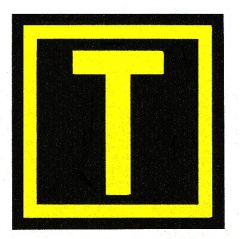
This sign tells you you're on ___. It may be co-located with a Runway Holding Position sign or Direction signs.
|

Taxiway Location Sign
This sign tells you you are on taxiway T. It may be co-located with a Runway Holding Position sign or Direction signs. |
|
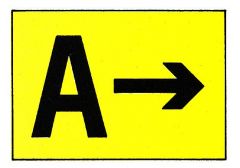
___ sign indicating that we need to make a right turn at the intersection to go to taxiway ___.
|

Direction sign indicating that we need to make a right turn at the intersection to go to taxiway A.
|
|
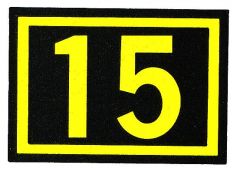
|

Runway Location Sign
Designates the runway on which the aircraft is located. |
|
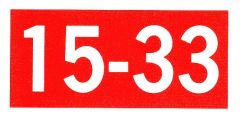
This sign is located at the ___ on ___ other runways.
|

Runway Holding Position Sign
This sign is located at the holding position on taxiways that intersect other runways. This one means the runway threshold for Runway 15 is located to the left and the threshold for 33 is to the right. The sign will be located adjacent to the holding position markings on the pavement. |
|
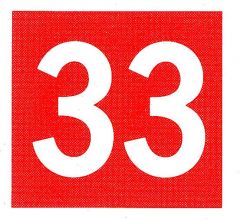
|

Runway Holding Position Sign
The taxiway only intersects the beginning of the takeoff runway. The sign will be located adjacent to the holding position markings on the pavement |
|
|
A circling approach is defined as
|
a visual maneuver (not VFR) performed after accomplishing an instrument approach to align the aircraft with the landing runway
|
|
|
Types of Circling
If the instrument procedure does not meet the criteria for a straight in landing. This criteria is: |
1. A maximum 400 ft/NM descent gradient from the FAF to runway threshold
2. A final approach course within 30° of the runway heading. 3. Final approach course doesn’t cross extended runway centerline prior to the runway threshold. |
|
|
Where do you find your aircraft approach category? ___ defines aircraft approach category as a means of grouping aircraft based on a speed of ___ (Stalling speed in the landing configuration) at ___.
|
Where do you find your aircraft approach category? FAR Part 97.3 defines aircraft approach category as a means of grouping aircraft based on a speed of 1.3 VSO (Stalling speed in the landing configuration) at maximum certified landing weight.
|
|
|
Category A:
Category B: Category C: Category D: Category E: |
Category A: Speed less than 91 knots.
Category B: Speed 91 knots or more but less than 121 knots. Category C: Speed 121 knots or more but less than 141 knots. Category D: Speed 141 knots or more but less than 166 knots. Category E: Speed 166 knots or greater. |
|
|
Circling Approaches
Must you go missed approach if you lose sight of the runway? |
No. You only need to keep the airport environment in sight. This is different from straight-in procedures.
|
|
|
When can we start our circling maneuver? 11-217:
|
After descending to Circling MDA and when airport environment is in sight, determine if the ceiling and vis are sufficient for performing the circling maneuver.
|
|
|
The airport environment is considered:
|
runway, lights, markings, taxiways, hangars etc
|
|
|
Except for ___ Instrument departure procedures are preplanned IFR procedures that provide obstruction clearance from the terminal area to the appropriate enroute structure.
(217 9.5) |
Diverse departures
|
|
|
___, are printed either ___ or ___.
___ are always printed ___ |
ODP's are printed either textually or graphically
SIDs are always printed graphically |
|
|
What are the 6 methods of departing IFR:
(217 9.6) |
Obstacle Departure Procedures (ODP); Textual or Graphic
Standard Instrument Departure Procedures (SID) Specific ATC Departure Instructions (including radar vectors) Diverse Departures Visual Climb over the Airport (VCOA) Special MAJCOM Certifications (authorized airports, aircrews and aircraft only) |
|
|
If an obstacle penetrates the 40:1 OCS. . . a ___ will be on all of the IAPs and SIDs for the airport.
(217 9.7) |
Trouble T
|
|
|
What is the "standard" FAA Takeoff Weather Minimums?
|
One statute mile visibility for AC with two engines or less and one-half statute mile for AC with more than two engines
|
|
|
What is the standard holding pattern?
|
At or below 14000 1min legs right turns
Above 14000 1.5min legs right hand turns |
|
|
If the aircraft is TACAN-only equipped, Do not hold directly over a ___ or a ___ facility or plan to use these facilities as ___
|
If the aircraft is TACAN-only equipped, do not hold directly over a TACAN or a VORTAC facility or plan to use these facilities as high altitude IAFs
|
|
|
ATC should issue holding instructions ___ min before reaching a clearance limit fix
|
5
|
|
|
___ min or less from a clearance limit and a clearance beyond the fix has not been received, the pilot is expected to start a speed ___
|
3 min or less from a clearance limit and a clearance beyond the fix has not been received, the pilot is expected to start a speed reduction so that the AC will cross the fix at or below the max holding AS.
|
|
|
What are the Max holding AS:
6000 and below ___ Above 6000 through 14000 ___ Above 14000 ___ |
What are the Max holding AS:
6000 and below 200KIAS Above 6000 through 14000 230KIAS Above 14000 265KIAS |
|
|
When are you considered established in holding?
|
You are considered established in the holding pattern upon initial passage of the holding fix.
|
|
|
Unless correcting for know winds, make all turns during entry and while holding at:
|
3 degrees/sec, or 30 degree AOB, or AOB commanded by the flight director, whichever requires the least
|
|
|
Windshear
How do you determine Reference Ground Speed (RSG) |
Vapp(TAS) - Sfc headwind = RSG
or Vapp(TAS) + Sfc tailwind = RSG |
|
|
Windshear
Stabalixe approach ___ AGL and/or prior to ___ |
1000
FAF |
|
|
Windshear
If the approach is not stablized ___, initiate go around |
at any point
|
|
|
Sever windshear is that which produces airspeed changes greater than ___ knots or vertical speed changes greater than ___ feet per minute.
|
15
500 |
|
|
Windshear Takeoff Procedures
If performance data allows, increase the rotation speed up to ___ knots, but do not reset the airspeed bugs. |
10
|

